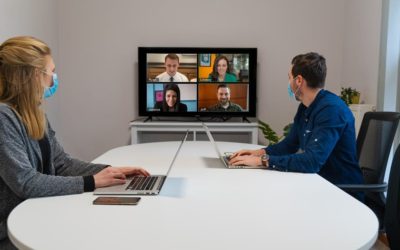For Librarians who Telework: Separating Work from Home
Miriam Kahn, MLS, PhD
Your office or place of business has shut down for the day, the week, the month. Perhaps you are told to work from home, to “telework”, that new term for telecommuters. How do you organize your day and keep yourself from working 24/7?
What types of boundaries do you set to separate work from your home life? In other words, how do you reset your daily work / life routine so you are productive and you don’t burn out?
Separating work from the rest of your life
On a normal day, in a normal world, it is fairly easy to separate work in the office from your life at home. Your attire reflects your work life; suit, office casual, and professional clothes. You change geographic locations and interact with colleagues in the office. When you arrive at home, you change clothes, you focus on chores like laundry and cooking, taking care of family members and the house or yard. That separation of work and home is built in and structured.
When you work from home, everything changes. Suddenly you have to make new boxes around your home life, to ignore those daily chores that stare at you when you take a coffee or lunch break, when you walk through your living spaces. Suddenly, work can become 24/7, an all day, every day drain on your life and vitality. You can work all the time and those work boundaries start to dissolve because it is easy to reach for the file, the computer, or the project. The phone rings, the texts chirp all day long, and you find it impossible to turn work off.
Before you burn out, it’s time to make new boxes.
Structure work space and time
Pick a place to set up your office, your space from which you will telework. That space should have a door that closes. Why? Why not work at the kitchen table? Because the kitchen is where you eat and relax, not a space where you can close the door on your working day, on your working materials. Your work space is just that, a place for work. It contains the phone, the work computer, and your work materials.
If possible, use a computer configured and secured for work that is different from one used for your home life. Many work places require use of a dongle, VPN, or specified and restricted internet access modes that are dedicated and more secure than your home computer systems.
Telecommuters who are easily distracted may elect to rent space in an office suite that provides copiers, meeting space, and even receptionists. Others work in spaces carved out of basements, garages, and even carriage houses. No matter where you set up your office space at home, it should be quiet, non-distracting, and have a door you can shut when you finish for the day.
Being a teleworker or telecommuter is a little different from being a free-lancer. The former is a dedicated worker with the expectation for being available from 9-5 or whatever your company work hours are.
Freelancers set their own schedules. When I was exclusively a full-time freelance consultant and a part-time professor, I worked from 7am to 2pm, then ran errands or held meetings with clients.
Ultimately, telecommuters and freelancers schedule their time based on the needs of clients.
Transition spaces or times
At lunchtime and the end of your work day, turn off and stow away the computer so that you are actually turning off the work day.
Once you’ve put your work life into a box or scheduled professional activities as a teleworker, it is time to create that transition from work life to home. Just as when you traveled to the office, change into casual work clothing, especially if you participate in video conferencing. Work attire shifts us unconsciously from home to work and back again. Change your clothes when you finish work to mark that daily shift in routine.
Develop a new end of workday routine where you go to the post office, copy shop, or the library for research, or meet friends for a drink, walk, or exercise. Set this time at the very end of your working day so you leave the house and transition into your home routine.
End of day is a great time to run those errands, shop for groceries, and even do the laundry—those activities that will distract you, grab your attention and perhaps prevent you from being productive.
Depending upon how you can structure your work day, you might run those errands or perform those home routines in the late afternoon.
Personal boxes
As we discussed in our last column on revitalizing your spirit and drive, personal boxes and transitions help shift your focus from work to home. These activities include exercise, library, friends, meditation and yoga, or even a good book read over a glass of wine or a cup of tea. Do whatever shifts your brain from work to your personal life and hobbies.
When working from home, you’ll need more personal boxes as buffers from work to home. A true shift in your mental and emotional focus involves using some ritual that cleanses and differentiates from work to home life. As a freelance consultant, I dedicate one work day to personal enrichment and revitalization. I read journal articles, research at the library, or network with colleagues over lunch or afternoon coffee. If you cannot schedule an entire day, then create smaller periods of time for weekly, crucial, revitalization time.
Personal boxes and home rituals may include changing clothing from work to home attire before cooking dinner or doing laundry. Household chores should be left for non-working hours.
Summing it up
Working from home as a teleworker or freelance consultant requires serious attention to scheduling (or putting boxes around) work and home life. Be realistic about scheduling time for meetings, research, and writing. Don’t forget revitalization and self-renewal, professional enrichment time, and the end of day routine.
Develop and maintain a routine schedule of work and home particularly if working from home is something new. That routine will keep you from burning out or allowing work to take over your personal life.
Some additional suggestions from a long-term freelance consultant.
- Schedule lunch meetings after 1:30 when the bulk of your work is probably behind you for the day.
- Set meetings at times that don’t break your work productivity momentum, or your focus.
- Schedule your research time, especially if you have a big project. Don’t let the research leach into your personal day.
- Take time to revitalize your professional interests.
Our next column will continue focusing on information professionals shifting from work to home routines.
Miriam Kahn, MLS, PhD
Miriam B. Kahn, MLS, PhD provides education and consulting for libraries, archives, corporations, and individuals. See Miriam’s pieces for Lucidea covering library technology and skills for special librarians. Refresh your knowledge of Lucidea’s flagship ILS, SydneyEnterprise, here.
Similar Posts
Interview with Miriam Kahn
Interview with librarian and consultant Miriam Kahn with her perspective on trends in special librarianship and the future of the profession.
Unconferences Benefit Special Libraries, Archives, and Museums
Unconferences are the perfect platform for LAM professionals to share ideas, trends, and techniques in this world of social distancing/remote working
Exploiting Socially Distanced Opportunities in GLAM – Crowdsourcing
Special libraries, archives, and museums can boost engagement through crowdsourcing transcription, which is also the perfect volunteer opportunity.
Enhance and Add Access Points for “Socially Distanced” Library Users
Skills for special librarians working in a digital environment include learning how to expand their library’s or organization’s online presence.
Hosting service
Enjoy all of the benefits of your Lucidea solution with secure, reliable, stress free hosting
Programs & incentives
No matter your size or budget, we’ve got you covered, today and tomorrow




Leave a Comment
Comments are reviewed and must adhere to our comments policy.
0 Comments